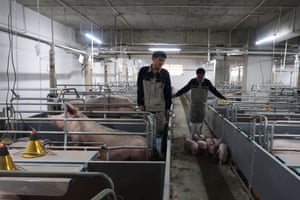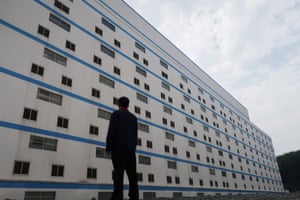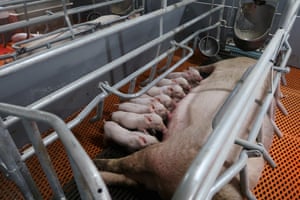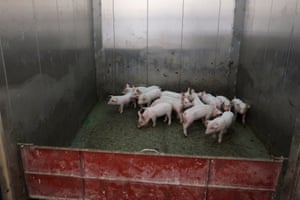The buildings do not even look like farms. They are huge grey concrete blocks, many storeys high, which stand side by side in the middle of what might look like a quarry, a “hole” of red earth dug in the heart of a mountain.
We are on the Yaji mountain, which in Chinese means “sacred”, a few kilometres south of the city of Guigang in southern China. What we are looking at is the tallest pig farm in the world; units up to nine storeys high housing thousands of pigs, with construction of a 12-storey pig unit under way.
“On each floor we can breed 1,270 pigs,” says Yuanfei Gao, vice-president of Yangxiang, the company that built the farm. “But in the future with the design of the new buildings we plan to have 1,300 pigs per floor.”
Yangxiang is one of the Chinese giants of the pork industry, producing about 2 million pigs a year in a dozen farms throughout China. The Yaji mountain site is its largest and most advanced multistorey farming system, and will have the capacity to produce around 840,000 pigs a year when construction is finished.
Over the past two years Chinese farmers and consumers have been rocked by pandemic after pandemic. Covid-19; an H1N1 swine flu that is now slowly spreading to farm workers; African swine fever (ASF), which has led to as many as 200 million pig deaths in a year; and a highly pathogenic foot-and-mouth disease, also in pigs, that vets now say is endemic.
But here are sky-high standards of biosecurity and sophisticated cleaning and disposal systems. Is this, some hope, the answer?

China’s pandemics
China is not the only country facing challenges from emerging zoonotic diseases, but it has become clear that the country faces bureaucratic, societal and ecological factors that magnify them into global threats.
“China is a conglomeration of every kind of driver for emerging diseases,” Peter Daszak, a zoologist and president of EcoHealth Alliance, a non-profit focused on global health issues, tells the Guardian. “You’ve got this incredible population density, which is expanding, and you’ve got incredible encroachment into wild areas.”
“The enormous density of pigs and chickens, most produced by small-to-medium-sized farms with poor biosecurity, interconnected with each other via transport networks to huge numbers of slaughterhouses and wet markets, also with poor hygiene, generates infectious disease risks,” says Dirk Pfeiffer, a professor of veterinary medicine at City University in Hong Kong and an expert on diseases related to animal husbandry.
China’s food supplies once depended on small farms, but as demand for meat has rocketed and animal disease risks rise, the strain on the old system has been acute. The problems are easy to spot. During a recent visit by the Guardian to a poultry facility near Shaoyang in Hunan province, where an outbreak of highly pathogenic H5N1 bird flu hit in late January, no netting could be seen to keep out wild birds that can pass the virus to chickens, though Yao Zuozhun, director of the Shaungqing District Animal Hygiene Supervision Centre, assured us that such netting had been in place.
On another trip, this time to a town in Yunnan province in south-west China, the Guardian was told that a bridge had only just been reopened after an outbreak of ASF – although no notification could be found of this outbreak.
“Some families still have small chicken flocks of 20 or 50 here in the suburbs, but the authorities want large chicken and pig farms to be further outside of the city to avoid pollution,” Zuozhun says. “No households are raising pigs now because the farmers can’t meet biosecurity standards.

“There used to be hardly any large-scale farms and household farms were a common sight. But over the past few years, the scene has gradually shifted to large farms for better hygiene and pollution control.”
Other problems for controlling disease include a lack of qualified vets – veterinary training has struggled to keep pace with the rapid growth of the farmed animals sector – and the overuse and misuse of antibiotics.
At the multistorey farm in Yaji, however, Gao says his company is already proving better at coping with disease. While ASF has led to the culling of millions of pigs in China over the past two years, it has been less devastating here. “Companies in China have lost about half of their animals. In Yangxiang we also had losses, but we managed to contain them to 10%.”
The Yaji site uses quarantine buildings for workers and company employees spend their lives in a dedicated residential area, complete with tennis courts.
“The quarantine area for the farm staff is divided in three parts,” says Lily Zou, spokesperson for the Yangxiang group, as we walk past buildings dedicated to employee quarantines.
“At the entrance they register their names, where they are from and to which farm they are headed. Then they pass through the disinfection process, for the hands, the clothes, the shoes, and also for phones and computers. Samples are taken for laboratory tests while they stay in the first quarantine area. If the results are negative, they can enter the last area for another two days, and from there be transported to the farms. But if the results are positive, they have to stay other days.”

Yangxiang employees enter the farm site and don’t leave until their next day off: “Every time people want to go to the farms, they need to go through this process and quarantine here,” Zou says.
The pigs are restricted to one floor for their whole lives to avoid mixing animals and each housing unit has a ventilation system, elevators for transporting animals and a specific pipeline to direct dead piglets to internal incineration areas.
But intensive farming systems like the multistorey Yaji site can still be a breeding ground for disease. “A concentrated farming operation creates a condition for cross infection among the pigs or other livestock animals,” says Peter Li, associate professor of east Asian politics at the University of Houston-Downtown in the US and a China policy specialist for the Humane Society International.
And the effect on the welfare of the animals that live in these spaces is still very poorly understood. Li believes that limited space, concrete floors, and inability to root and display other natural behaviours, and a perennial sense of frustration, can lead to a decline in the pigs immunity.
“These farms are very health-focused, and there’s a longstanding belief that that good health equals good welfare. But actually that is not always the case,” says Jeremy Marchant-Forde, research animal scientist with the US Department of Agriculture. “Welfare within that type of environment, a very intensive system, is very different to typical UK outdoor production, for example. It may well have some advantages with regard to health. But at the end of the day you couldn’t call this high welfare. There is not a lot of room or environmental complexity here just to let pigs be pigs.”

Jeff Zhou, chief representative at Compassion in World Farming in Beijing, says progress is being made with animal welfare issues but that the issue is still only understood “at a low level” in China.
“Some companies are trying to take these things into practice, but in the larger picture, compared to the number of animals, and the number of big production systems, [the adoption of better practices] is still very small, very little,” he says.
Ultimately, while China may have one foot in the 21st century, it still has another dragging behind, says Daszak.
“I have great confidence that in 30 to 50 years, China will be extremely efficient and safe, but getting from here to there is the hard part. Whether that is enough time to stop the next pandemic before it starts is a question weighing on the minds of many following emerging diseases these days,” he says.
Additional research by Jonathan Zhong
Sign up for the Animals farmed monthly update to get a roundup of the best farming and food stories across the world and keep up with our investigations. You can send us your stories and thoughts at animalsfarmed@theguardian.com